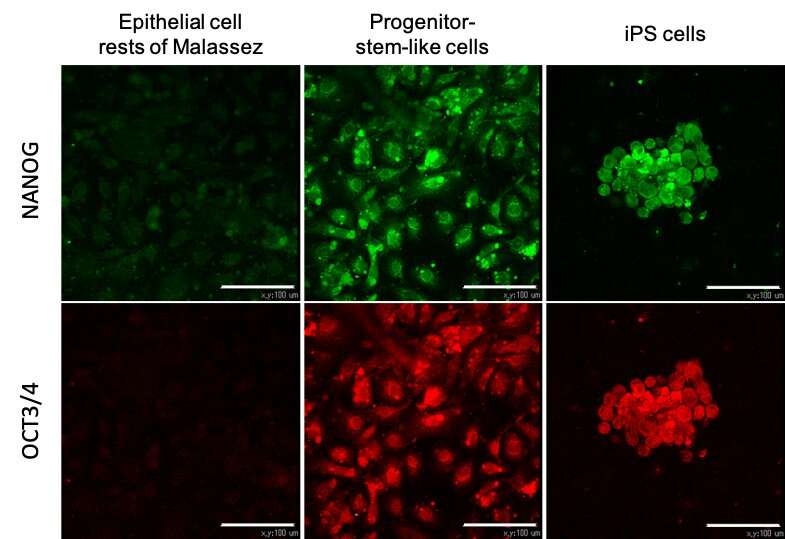The expression levels of Cd31, a marker for endothelial cells, and Cd90, a marker for mesenchymal stem cells, in the endothelial- and mesenchymal stem cell-like cells differentiated from progenitor-stem-like cells were similar to those in the endothelial and mesenchymal stem cells. Credit: Scientific Reports
Epithelial cell rests of Malassez derived from the periodontal ligament were transformed into progenitor stem-like cells by stimulation with epigenetic agents. Subsequently, the progenitor stem-like cells were directly differentiated into endothelial, mesenchymal stem, and osteogenic cells that constitute the periodontal ligament.
Stem cells derived from the dental pulp or periodontal ligament have been used for regenerative dentistry. Although it is relatively easy to collect the dental pulp stem cells, it is difficult to obtain adequate numbers of good quality cells; a stable supply is required for their application in regenerative dentistry. In the present study, we generated the progenitor-stem-like cells from ERM cells in the periodontal ligament using the epigenetic modifications without gene transfer. The progenitor stem-like cells were differentiated into endothelial, mesenchymal stem, and osteogenic cells—which constitute the periodontal ligament—using a direct reprogramming method that induces the differentiation of progenitor stem cells into the target cells.
The isolated ERM cells were induced to differentiate into progenitor stem-like cells, which were similar to stem cells, following stimulation with the epigenetic agents, 5-Azacytidine and valproic acid, for 1 week. The progenitor stem-like cells expressed the protein stem cell markers NANOG and OCT3/4, which were also observed in the iPS cells.
-
NANOG and OCT3/4 were expressed in the progenitor stem-like cells and iPS cells, whereas no expression was detected in the ERM cells. Credit: Scientific Reports
-
The progenitor-stem-like cells showed positive staining for calcification as determined by Alizarin Red, similar to that observed in the iPS cells. Credit: Scientific Reports
The progenitor stem-like cells were differentiated into endothelial, mesenchymal stem, and osteogenic cells. The expression of the specific marker for each cell type was confirmed.
The findings of the present study may contribute to the development of new periodontal regenerative therapy. Epigenetic agents have been successfully applied in various human diseases, including cancers. Nonetheless, further investigations are needed to confirm the findings of this study.
More information: Koki Yoshida et al, Direct reprogramming of epithelial cell rests of malassez into mesenchymal-like cells by epigenetic agents, Scientific Reports (2021). DOI: 10.1038/s41598-020-79426-4
Journal information: Scientific Reports
Provided by Health Sciences University of Hokkaido

























